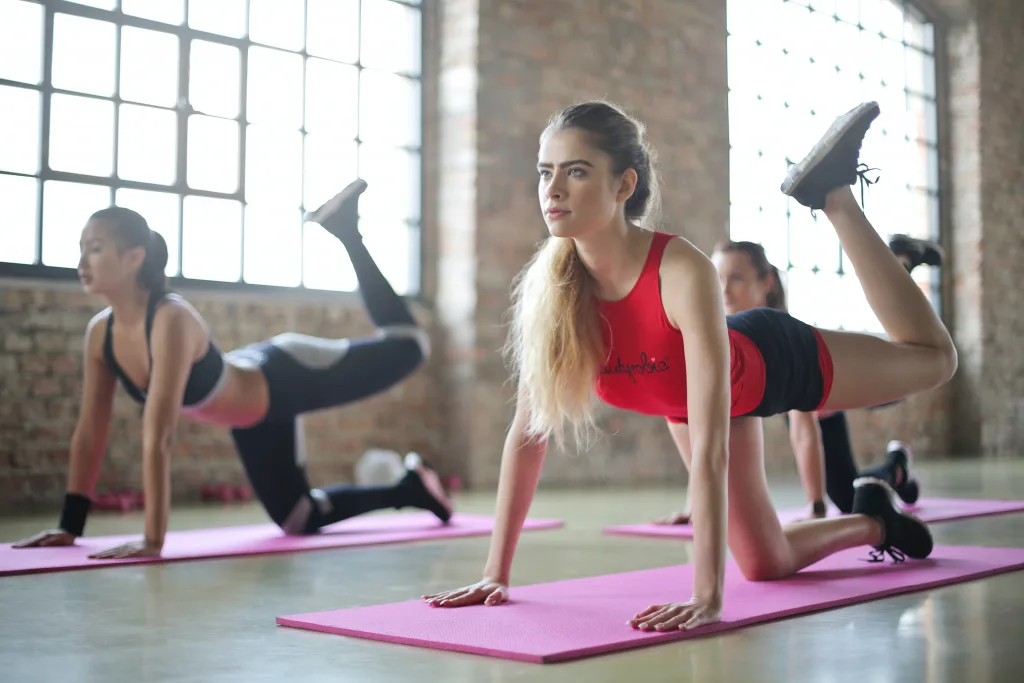When it comes to exercise for overweight individuals, finding low-impact activities that are both effective and enjoyable is key. The goal is to gradually build stamina and improve fitness without causing unnecessary strain on the body. The American Heart Association recommends at least 150 minutes of moderate exercise per week, which can be broken down into manageable increments.
Whether it’s walking, swimming, or cycling, there are plenty of options available to help overweight individuals ease into a regular exercise routine. By starting with activities that are comfortable and enjoyable, you can gradually work your way up to longer and more intense workouts. Let’s explore some of the best low-impact exercises for overweight individuals that can pave the way to a healthier lifestyle.

Low-impact exercises for overweight individuals: General Fitness
When it comes to improving overall fitness levels, low-impact exercises can be a great option for overweight individuals. These exercises are gentle on the joints and reduce the risk of injury, making them suitable for individuals with excess weight. The Centers for Disease Control and Prevention (CDC) has provided minimum recommendations for physical activity, which serve as a helpful starting point for beginners.
Minimum recommendations by CDC
According to the CDC, adults should aim for at least 150 minutes of moderate-intensity aerobic activity per week, along with muscle-strengthening exercises on two or more days. For overweight individuals, it’s essential to gradually build up to these recommendations to prevent strain or overexertion.
Walking
Walking is a fantastic low-impact exercise that can be easily incorporated into daily routines. It requires no special equipment and can be done almost anywhere. Brisk walking not only helps burn calories but also improves cardiovascular health. Consider taking scenic routes or exploring local parks to make the activity more enjoyable.
Swimming
Swimming is an excellent option for overweight individuals as it provides a full-body workout without placing excessive stress on the joints. The water’s buoyancy supports the body, reducing the risk of impact-related injuries. Additionally, swimming engages various muscle groups and improves flexibility.
Cycling
Cycling is a low-impact exercise that can be tailored to individual fitness levels. It can be done outdoors on a bicycle or indoors using a stationary bike. Cycling helps strengthen the leg muscles, improves cardiovascular endurance, and aids in weight loss. Consider starting with shorter rides and gradually increasing the duration and intensity.
Yoga
Yoga combines gentle movements, stretching, and deep breathing exercises, making it an ideal low-impact activity for overweight individuals. It promotes flexibility, improves balance, and strengthens muscles. Many yoga studios offer beginner-friendly classes that focus on modified poses to accommodate different body types and fitness levels.
Strength training with resistance bands
Strength training is essential for overall fitness and weight management. Using resistance bands can offer a low-impact alternative to traditional weight lifting. These bands provide resistance during exercises, helping build muscle strength and tone without putting excessive strain on the joints. Resistance bands are portable and versatile, allowing for a wide range of exercises to target different muscle groups.
Remember to consult with a healthcare professional before starting any exercise routine, especially if you have any underlying health conditions. They can provide personalized advice and guidelines based on your specific needs and limitations.
By incorporating these low-impact exercises into your fitness routine, you can improve strength, flexibility, and overall fitness levels while minimizing the risk of injury. Start slowly, listen to your body, and gradually increase the duration and intensity of your workouts over time. Stay consistent, be patient, and celebrate every small achievement along the way. Weight Loss
A combination of aerobic and strength training exercises can be highly effective for weight loss in overweight individuals. By incorporating both types of exercises into your routine, you can maximize calorie burn and build lean muscle mass, resulting in accelerated weight loss. Let’s explore how these exercise modalities can work together to help you shed those extra pounds.
Aerobic Exercises for Weight Loss
Aerobic exercises, also known as cardio exercises, are great for burning calories and increasing your heart rate. These exercises elevate your breathing and heart rate, resulting in increased energy expenditure. Here are some examples of low-impact aerobic exercises suitable for overweight individuals:
- Walking: Walking is an excellent low-impact exercise that can be done almost anywhere. Start with shorter distances and gradually increase the duration and intensity of your walks.
- Swimming: Swimming is a full-body workout that puts minimal stress on your joints. It provides an excellent cardiovascular workout while being gentle on your body.
- Cycling: Cycling, either outdoors or on a stationary bike, is a fantastic low-impact aerobic exercise that can help you burn calories and boost your fitness levels.

Strength Training for Weight Loss
Many people mistakenly believe that strength training is only for building muscle. However, incorporating strength training exercises into your weight loss routine is crucial. Here’s why:
- Increased calorie burn: Strength training increases muscle mass, which helps to improve your metabolism. As a result, you burn more calories throughout the day, even when at rest.
- Body composition: Strength training helps to decrease body fat while simultaneously increasing muscle mass. This improves your overall body composition, making you leaner and more toned.
- Enhanced functional movement: Strength training exercises target specific muscle groups, helping to improve your strength and stability. This can make everyday activities easier and reduce the risk of injury.
So, don’t shy away from incorporating strength training into your weight loss routine. It can be as simple as using resistance bands, lifting weights, or engaging in bodyweight exercises.

By combining aerobic exercises with strength training, you create a comprehensive workout routine that maximizes calorie burn, promotes muscle growth, and leads to sustainable weight loss. Remember to start slowly and gradually increase the intensity and duration of your workouts as your fitness levels improve.
Keep in mind that weight loss is not only about exercise; a balanced diet is equally important. Consider consulting with a registered dietitian or a healthcare professional to create a personalized nutrition plan that complements your exercise routine.
For more information on weight loss exercises and tips, you can visit websites like WebMD or Healthline, which provide valuable resources and expert guidance to support your weight loss journey.
Mental Health
Exercise as stress-relief and empowerment.
Exercise is not only beneficial for physical health, but it also plays a crucial role in supporting mental well-being. For overweight individuals, engaging in low-impact exercises can be a great way to relieve stress and empower themselves on their fitness journey.
Stress-relief through exercise
Exercise has been proven to be an effective stress-reliever for individuals of all sizes. It helps to release endorphins, which are known as “feel-good” hormones, and can help alleviate symptoms of anxiety and depression. When overweight individuals participate in low-impact exercises, such as walking, swimming, or cycling, they can experience the same stress-relieving benefits as any other individual.
Regular exercise provides an opportunity to break away from daily stressors and focus on the present moment. It serves as an outlet to release tension and allows individuals to disconnect from their worries. Engaging in low-impact exercises allows overweight individuals to improve their mental well-being while protecting their joints and avoiding excessive strain on their bodies.
Empowerment through movement
For overweight individuals, engaging in low-impact exercises can also help foster a sense of empowerment. Exercise is not solely about weight loss or conforming to societal expectations. It is about embracing one’s body, appreciating its capabilities, and celebrating what it can do.
By focusing on movement as a form of empowerment, individuals can shift their mindset and redefine their relationship with exercise. This approach can help overcome the fear of judgment or failure that may arise when starting a fitness routine.
When overweight individuals engage in low-impact exercises, they can gradually build strength and endurance, thus gaining confidence in their physical abilities. Every step taken, every stroke swum, or every pedal pushed becomes a testament to their resilience and determination.
Through exercise, overweight individuals can challenge societal norms and expectations, proving that health and fitness come in diverse shapes and sizes.

To learn more about the mental health benefits of exercise, visit www.mindbodygreen.com for insightful articles and resources.
Exercise not only benefits physical health but also supports mental well-being. For overweight individuals, engaging in low-impact exercises can provide stress-relief and empower them on their fitness journey. By focusing on movement as a form of empowerment rather than weight loss, individuals can improve their mental well-being while challenging societal norms. Stay tuned for the next section on the importance of finding enjoyable exercises.
Conclusion
In conclusion, incorporating low-impact exercises into a fitness routine is a smart choice for overweight individuals looking to improve their health and well-being. These exercises provide a gentle and safe way to increase physical activity without putting excessive strain on the joints.
By regularly engaging in low-impact exercises such as walking, swimming, cycling, or using an elliptical machine, overweight individuals can gradually build strength, increase endurance, and burn calories. Additionally, these exercises can help improve cardiovascular health, reduce the risk of chronic diseases, and boost overall mood and mental well-being. Remember, consistency is key when it comes to reaping the benefits of low-impact exercises. So start small, stay committed, and enjoy the journey towards a healthier lifestyle.
Thank you for reading this post, don't forget to subscribe to our free newsletter
!
